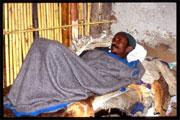 Spare some time? Computing hours can now be used to help the fight against malaria.© WHO
Spare some time? Computing hours can now be used to help the fight against malaria.© WHOResearchers want the help of your home computer for an urgent new mission: fighting malaria.
Malaria kills more than 1 million people every year, mostly young children in Africa. Many researchers build computer models to mimic the spread of the disease. But such efforts would take vast amounts of computer power if scientists wanted to include all the various complicated factors of how the parasite hops from mosquito to human and back, and how each person's immune system reacts differently.
Enter MalariaControl.net, a new project involving several research institutions in Europe and Africa, and coordinated by the particle-physics lab CERN. The organizers are asking members of the public to download software on to their computers that runs while machines are idle.
This type of distributed computing is already being used to search for extraterrestrial life and to predict climate change and protein structures. MalariaControl.net uses the same software and is the first to harness it for disease modelling.
The results could help governments and aid organizations to decide how best to deploy future vaccines against the disease or distribute insecticide-treated nets and drugs. "This is a great project," says Simon Hay, who studies malaria epidemiology at the University of Oxford, UK. "I encourage others to be generous with their CPU time."
Model investment
The computers signed up to MalariaControl.net will run a model that has been in development by Tom Smith at the Swiss Tropical Institute, Basel, and his colleagues since 2003. The team originally wanted to predict the amount of protection afforded by a prototype malaria vaccine in order to decide how effective it must be before it is worth investing in.
The model attempts to individually simulate malaria infection in each of 50,000 to 100,000 people over a lifetime. It simulates how often each individual is bitten, becomes infected and fights off an infection, plus their age, health, changing number of parasites in the blood and level of immunity. It updates this information every 5 days over a population's lifetime, a computing feat that takes about an hour to tot up on an average PC.
To refine the model, the researchers have to adjust each component multiple times until it best mimics real data collected from infected areas. This means they must run the simulations many thousands of times, eating up thousands of hours of computing time.
The team has already carried out a pilot project using 40 computers, and the results will be published next month. They found from their modelling that the malaria vaccine being tested (GlaxoSmithKline's RTS,S jab) would be around one-third as effective in real life as it was in the controlled conditions of a clinical trial.
But infectious-disease researcher Azra Ghani of the London School of Hygiene and Tropical Medicine points out that gathering more data about patterns of malaria exposure and infection will also be crucial, otherwise it won't be possible to tell whether these extensive models are accurate.
Heavy load
Now the team wants to compare different models and include in their simulations the number of mosquitoes that each person attracts. They also want to find out how the natural immunity triggered by an infection, which decays over time, affects their predictions. "All these things lead to major computing loads," Smith says.
Around 2,800 people have already enlisted for MalariaControl.net and the team hopes to recruit about 10,000 in total. Smith says that the results should emerge within a few months and will eventually be put into an open-access database.
The project is the first to be launched as part of a broader scheme called Africa@home, which aims to find distributed computing projects that both help and involve Africans. The participants are already talking with other researchers about starting similar schemes to carry out epidemiological modelling of tuberculosis and HIV, says coordinator François Grey of CERN.
ADVERTISEMENT
Ghani says that distributed computing might prove particularly valuable for very fast, real-time calculations of an infectious-disease outbreak such as avian flu, when there isn't time to run leisurely models before something needs to be done.
Visit our computersforahumanit.html">newsblog to read and post comments about this story.
